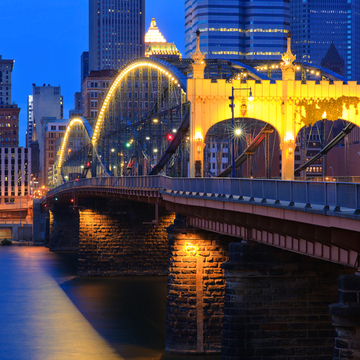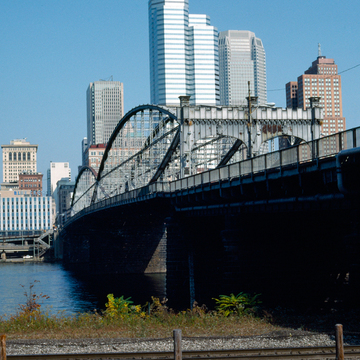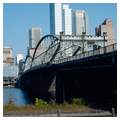This, the oldest of Pittsburgh's extant bridges, is the third at this site. The first on this site and in Pittsburgh was the covered wooden Monongahela Bridge of 1818 built by Lewis Wernwag to replace a ferry crossing, four years after he had completed an unparalleled 340-foot single-span timber bridge in Philadelphia. Destroyed in the Great Fire of 1845, it was replaced by John A. Roebling's Monongahela Suspension Bridge. When traffic loads reduced its stability a generation later, this second bridge was torn down.
Construction of the present bridge began in 1880 under Charles Davis. Only the sandstone piers of his design were erected when he was replaced by Gustav Lindenthal, who used the piers to carry a combination of an arch and a suspension bridge. This lenticular truss, which resembles a double convex lens seen on edge, is typical of design and engineering of the era, using small pieces that were easily manufactured, assembled, and transported to the site. There are two 360-foot spans, for a total length of 1,185 feet with approach spans. As one of the first primarily steel highway bridges in the United States, Smithfield fittingly marked both the transition of bridge materials from wrought iron to steel and the coming of age of Pittsburgh's steel industry.
In 1889, two trusses were added parallel to the original ones to accommodate horsecars. These were moved to widen the bridge for electric streetcars in 1911, which required replacing Lindenthal's original portals with the Gothic Revival entranceways of 1915 by Stanley Roush that stand today. The current aluminum railings were installed in 1933 in conjunction with an aluminum deck—the first use of structural aluminum in a bridge. Over the years, the piers have been reinforced with concrete, and decorative lighting was added to the upper arches of the trusses, to make the bridge equally distinctive at night.





